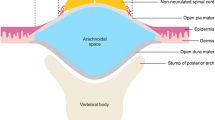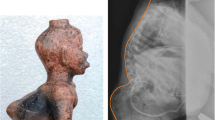Abstract
Purpose
Myelomeningocele (MMC) is the representative entity of open neural tube defects resulting from an error during primary neurulation. However, cases of MMC in the region of the secondary neural tube (below the junction of S1 and S2 vertebrae) are sometimes encountered. We aimed to analyze the clinical features of atypical “low-lying” MMC in comparison to the typical MMC and suggest possible pathoembryogenesis.
Methods
From 1986 to 2020, 95 MMC patients were treated in our institute. A retrospective review of the radiological and clinical information was performed. We defined “low-lying” MMCs as those with fascia or lamina defects below the S1-2 interspinous ligament.
Results
Thirty-one out of the 95 MMC patients were identified as having low-lying MMC. The percentage of low-lying MMC within the entire MMC group increased dramatically (19% from 1990 to 1999 and 48% from 2000 to 2020). Thirty-nine percent of the low-lying MMCs were associated with hydrocephalus, and 36% showed the Chiari malformation. Clean intermittent catheterization was being performed by 52% of the patients and 46% had a motor weakness. The proportions of hydrocephalus, neurological symptoms, and the number of related procedures in the low-lying MMC were substantially lower than the typical MMC in our cohort and the literature.
Conclusions
We present cases of atypical MMC occurring in the region of secondary neurulation. These cases provide clues that secondary neurulation may lead to open neural defects. Future experiments with animal models supporting what we have seen in the clinics will greatly enhance the understanding of the developmental process of neurulation and the corresponding anomalies.





Similar content being viewed by others
Availability of data and material
The datasets generated during and/or analyzed during the current study are available from the corresponding author on reasonable request.
Change history
24 November 2022
A Correction to this paper has been published: https://doi.org/10.1007/s00381-022-05762-7
Abbreviations
- MMC:
-
Myelomeningocele
- CNS:
-
Central nervous system
- CCM:
-
Caudal cell mass
- MRI:
-
Magnetic resonance imaging
- VP:
-
Ventriculoperitoneal
- FMD:
-
Foramen magnum decompression
- CIC:
-
Clean intermittent catheterization
- UDS:
-
Urodynamic study
- VUR:
-
Vesicoureteral reflux
- DMSA:
-
Dimercaptosuccinic acid
- DSD:
-
Dyssynergia
- EMG:
-
Electromyography
- TMCC:
-
Terminal myelocystocele
References
O’Rahilly R, Müller F (1994) Neurulation in the normal human embryo. Ciba Found Symp 181:70–82; discussion 82–79
Copp AJ, Stanier P, Greene ND (2013) Neural tube defects: recent advances, unsolved questions, and controversies. Lancet Neurol 12:799–810
Dias MS (2007) Normal and abnormal development of the spine. Neurosurg Clin N Am 18:415–429
Yang J, Lee JY, Kim KH, Wang KC (2021) Disorders of secondary neurulation: mainly focused on pathoembryogenesis. J Korean Neurosurg Soc 64:386–405
Müller F, O’Rahilly R (1987) The development of the human-brain, the closure of the caudal neuropore, and the beginning of secondary neurulation at stage-12. Anat Embryol 176:413–430
Januschek E, Rohrig A, Kunze S, Fremerey C, Wiebe B, Messing-Junger M (2016) Myelomeningocele - a single institute analysis of the years 2007 to 2015. Child Nerv Syst 32:1281–1287
Eibach S, Moes G, Hou YJ, Zovickian J, Pang D (2021) New surgical paradigm for open neural tube defects. Child Nerv Syst 37:529–538
Swank M, Dias L (1992) Myelomeningocele: a review of the orthopaedic aspects of 206 patients treated from birth with no selection criteria. Dev Med Child Neurol 34:1047–1052
Steinbok P, Irvine B, Cochrane DD, Irwin BJ (1992) Long-term outcome and complications of children born with meningomyelocele. Child Nerv Syst 8:92–96
Colas JF, Schoenwolf GC (2001) Towards a cellular and molecular understanding of neurulation. Dev Dyn 221:117–145
Dady A, Havis E, Escriou V, Catala M, Duband JL (2014) Junctional neurulation: a unique developmental program shaping a discrete region of the spinal cord highly susceptible to neural tube defects. J Neurosci 34:13208–13221
Schoenwolf GC, Delongo J (1980) Ultrastructure of secondary neurulation in the chick embryo. Am J Anat 158:43–63
Lee JY, Kim SP, Kim SW, Park SH, Choi JW, Phi JH, Kim SK, Pang D, Wang KC (2013) Pathoembryogenesis of terminal myelocystocele: terminal balloon in secondary neurulation of the chick embryo. Childs Nerv Syst 29:1683–1688
Pang D, Wang K-C (2013) In Reply. Neurosurgery 72:E698–E700
Yang HJ, Lee DH, Lee YJ, Chi JG, Lee JY, Phi JH, Kim SK, Cho BK, Wang KC (2014) Secondary neurulation of human embryos: morphological changes and the expression of neuronal antigens. Childs Nerv Syst 30:73–82
Schumacher S (1928) Über Bildungs-und Rückbildungsvorgänge am Schwanzende des Medullarrohres bei älteren Hühnerembryonen mit besonderer Berücksichtigung des Auftretens eines „sekundären hinteren Neuroporus “. Z Mikrosk Anat Forsch 13:269–327
Kellogg R, Lee P, Deibert CP, Tempel Z, Zwagerman NT, Bonfield CM, Johnson S, Greene S (2018) Twenty years’ experience with myelomeningocele management at a single institution: lessons learned. J Neurosurg-Pediatr 22:439–443
Bowman RM, Boshnjaku V, McLone DG (2009) The changing incidence of myelomeningocele and its impact on pediatric neurosurgery: a review from the Children’s Memorial Hospital. Child Nerv Syst 25:801–806
Coleman BG, Langer JE, Horii SC (2015) The diagnostic features of Spina bifida: the role of ultrasound. Fetal Diagn Ther 37:179–196
Lee JY, Kim KH, Park K, Wang KC (2020) Retethering: a neurosurgical viewpoint. J Korean Neurosurg Soc 63:346–357
Takamiya S, Seki T, Ikeda T, Shinada S, Hamauchi S, Terasaka S, Houkin K (2018) Myelocystocele mimicking myelomeningocele: a case report and review of the literature. World Neurosurg 119:172–175
Catala M (2021) Overview of secondary neurulation. J Korean Neurosurg Soc 64:346–358
Catala M, Teillet MA, DeRobertis EM, LeDouarin NM (1996) A spinal cord fate map in the avian embryo: while regressing, Hensen’s node lays down the notochord and floor plate thus joining the spinal cord lateral walls. Development 122:2599–2610
Funding
This work was supported by the National Research Foundation of Korea (NRF) Grant funded by the Korean Government (MSIP) (NRF-2021M3E5D9021884). This work was also supported by the Education and Research Encouragement Fund of Seoul National University Hospital (J. Y. Lee).
Author information
Authors and Affiliations
Contributions
Ji Yeoun Lee, Kyu-Chang Wang conceptualized and designed the study, collected the data, carried out the initial analyses, drafted the initial manuscript, and reviewed and revised the manuscript. Joo Whan Kim, Youngbo Shim, and Saet Pyoul Kim collected the data and performed the statistical analysis. Kyung Hyun Kim, Jeyul Yang, and Seung-Ki Kim critically reviewed the manuscript for important intellectual content. All authors approved the final manuscript as submitted and agree to be accountable for all aspects of the work.
Corresponding author
Ethics declarations
Ethics approval
The Institutional Review Boards (IRB) of our institution approved this study, and patient consent was not required. The procedures used in this study adhere to the tenets of the Declaration of Helsinki.
Consent for publication
The waiver of consent was granted under IRB review.
Conflict of interest
The authors report no conflict of interest concerning the materials of methods used in this study or the findings specified in this paper.
Additional information
Publisher's Note
Springer Nature remains neutral with regard to jurisdictional claims in published maps and institutional affiliations.
The original online version of this article was revised: In this article the references in Table 1 are incorrectly cited. Given here is the corrected table.
Rights and permissions
Springer Nature or its licensor (e.g. a society or other partner) holds exclusive rights to this article under a publishing agreement with the author(s) or other rightsholder(s); author self-archiving of the accepted manuscript version of this article is solely governed by the terms of such publishing agreement and applicable law.
About this article
Cite this article
Lee, J.Y., Kim, J.W., Shim, Y. et al. Myelomeningocele as an anomaly of secondary neurulation. Childs Nerv Syst 38, 2091–2099 (2022). https://doi.org/10.1007/s00381-022-05591-8
Received:
Accepted:
Published:
Issue Date:
DOI: https://doi.org/10.1007/s00381-022-05591-8




